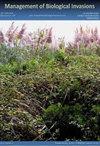美国西部贻贝浮游生物拖曳探测概率的初步评估
IF 1.2
4区 环境科学与生态学
Q3 BIODIVERSITY CONSERVATION
引用次数: 0
摘要
早期发现多形贻贝(Dreissena polymorpha)和芽状贻贝(D. rostriformis bugensis)对于减轻侵染对经济和环境的影响至关重要。浮游生物拖曳取样是一种常用的早期检测德雷氏贻贝的方法,但对使用该方法进行高概率早期检测所需的取样强度知之甚少。我们使用隐式动态占用模型,从美国中部和西部收集的浮游生物拖曳样本的长期数据集中估计dreissenid贻贝的浮游生物拖曳检测概率。我们使用a)整个数据集来拟合模型,包括除严重侵染水体外占用状态未知的水体,b)包含成对水温数据的水体的数据子集,以及c)包含低密度水体的数据子集。对于整个数据集,我们发现估计的检测概率因水体大小而异,范围约为0.10至0.86。对于水温子集,我们观察到与完整数据相同的检测概率和水体大小之间的模式,但另外发现,当水温高于12°C时,估计的检测概率要高得多。对于低密度的贻贝,我们发现用单个聚集的浮游生物样本检测贻贝的估计概率接近于零。根据这些估计,我们得出结论,数据中每个水体中采集的浮游生物拖带样本的总数远远少于确保高概率检测到德莱森贻贝所需的数量,特别是当它们的密度很低时。我们总结了这些分析,并讨论了浮游生物拖取样方案的变化,以提高对德雷森德检测概率的估计。本文章由计算机程序翻译,如有差异,请以英文原文为准。
An initial assessment of plankton tow detection probabilities for dreissenid mussels in the western United States
Early detection of dreissenid mussels ( Dreissena polymorpha and D. rostriformis bugensis ) is crucial to mitigating the economic and environmental impacts of an infestation. Plankton tow sampling is a common method used for early detection of dreissenid mussels, but little is known about the sampling intensity required for a high probability of early detection using the method. We used implicit dynamic occupancy models to estimate plankton tow detection probabilities of dreissenid mussels from a long-term data set containing plankton tow samples collected across central and western United States. We fit models using a) the entire data set, including water bodies with unknown occupancy status in addition to heavily infested water bodies, b) a data subset that included water bodies with paired water temperature data, and c) a data subset that included water bodies with lower dreissenid densities. For the entire data set, we found that estimated detection probabilities varied by water body size and ranged from approximately 0.10 to 0.86. For the water temperature subset, we observed the same pattern between detection probability and water body size as we did for the full data but additionally found that the estimated detection probabilities were much higher when water temperatures were above 12 °C. For the lower dreissenid density subset, we found that the estimated probability of detecting dreissenid mussels with a single aggregated plankton tow sample was near zero. Given these estimates, we conclude that the number of aggregated plankton tow samples taken per water body in the data is far fewer than the number needed to ensure a high probability of detecting dreissenid mussels, especially if they are at low densities. We summarize the analyses with a discussion of plankton tow sampling protocol changes needed to improve estimates of dreissenid detection probabilities.
求助全文
通过发布文献求助,成功后即可免费获取论文全文。
去求助
来源期刊

Management of Biological Invasions
Agricultural and Biological Sciences-Ecology, Evolution, Behavior and Systematics
CiteScore
3.40
自引率
6.70%
发文量
21
审稿时长
16 weeks
期刊介绍:
Management of Biological Invasions, established in 2010 by Dr. Elias Dana, is an open access, peer-reviewed international journal focusing on applied research in biological invasions in aquatic and terrestrial ecosystems from around the world. This journal is devoted to bridging the gap between scientific research and the use of science in decision-making, regulation and management in the area of invasive species introduction and biodiversity conservation.
Managing biological invasions is a crisis science, with Management of Biological Invasions aiming to provide insights to the issues, to document new forms of detection, measurements and analysis, and to document tangible solutions to this problem.
In addition to original research on applied issues, Management of Biological Invasions publishes technical reports on new management technologies of invasive species and also the proceedings of relevant international meetings. As a platform to encourage informed discussion on matters of national and international importance, we publish viewpoint papers that highlight emerging issues, showcase initiatives, and present opinions of leading researchers.
 求助内容:
求助内容: 应助结果提醒方式:
应助结果提醒方式:


